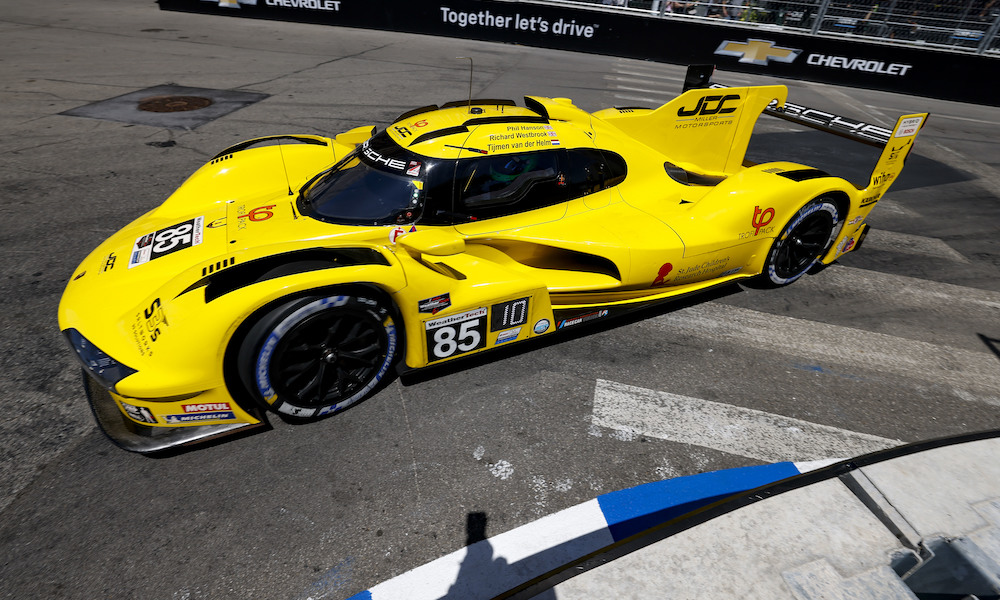With the future of Porsche’s 963 customer stable looking unclear for 2025 and beyond, Porsche LMDh boss Urs Kuratle has revealed that talks are ongoing with “people in IMSA” about future programs as the third year of the LMDh ruleset approaches.
Currently, there are five privateer Porsche 963s in circulation, with Proton and JOTA running two cars apiece and JDC Miller running the fifth. But the cost of competing in Hypercar and GTP as a private team is only getting steeper, and it’s now not a given that all three teams will be back next season.
While JDC-Miller is working on running a second car in IMSA GTP for 2025, Proton Competition – which currently runs a single 963 in the FIA WEC and IMSA – is yet to decide on its future in both championships and Hertz Team JOTA now appears likely to move its WEC program elsewhere.
While speaking with select outlets including RACER at Interlagos last weekend, Kuratle was asked directly for an update on the future of Porsche’s LMDh customer project.
“We are in discussions with all the customers and if the situation is that we need to or should sell some more cars, then we will sell more cars. But it is not decided yet,” he said.
“There would be (additional) cars available (in 2025). It’s not that the cars are built, we would have to build them, but the chassis are available and parts are available. It’s a question of the demand. We are talking to people in IMSA in the United States, and it’s all open for now.”
[lawrence-auto-related count=3 category=1406]
Whether or not there is real demand for new cars is the (multi) million dollar question.
Kuratle was asked directly about the impact that a rumored brand switch for JOTA away from Porsche would have on capacity and numbers. He didn’t confirm nor deny whether or not the British team was moving on. Instead, he spoke in hypotheticals about the potential of a JOTA-sized gap appearing. He made it clear that multiple scenarios are on the table going forward and said that there is not one ideal solution.
“If JOTA leaves, then the customer support has some capacity and we will have to see how we will deal with it. Whether that’s a replacement customer or not is up for discussion,” he said.
“Having three (privateer cars in WEC) is something you can work with,” he continued when asked whether or not the current number in the WEC is ideal. “We have made big steps in reliability and that’s because we’ve been able to complete more kilometers with customers.”
Attracting new customer teams for 2025 will be a hard task. With eight-figure budgets understood to be required for customer Hypercar and GTP programs, you can count the number of teams ready, willing and able on one hand.
There’s also the question of grid space in the WEC, which is set to expand from 37 to 40 cars in 2025. But that additional capacity is likely already accounted for. Cadillac, Lamborghini and Isotta Fraschini are all working on bringing an additional car apiece to meet the two-car rule requirement, and Aston Martin is entering with two Valkyries.
Hypothetically, with an identical 18-car LMGT3 field, the five aforementioned additional factory cars and all the current two-car factories returning, even with JOTA’s customer cars gone that count reaches 40, leaving no obvious space for new blood. This, according to JOTA boss Sam Hignett, is unlikely to be a problem though.
“I don’t think there are many privateer teams that are waiting to get into WEC at the moment,” he told RACER when asked for his thoughts on the two-car rule’s impact on the entry.
“I think it’s a very small market. There are three very good teams doing it at the moment but I am not hearing of any teams knocking down the door trying to get in.”
That leaves IMSA’s GTP class, though the WeatherTech SportsCar Championship is already running to a capacity grid, even before Aston Martin joins its ranks with Heart of Racing.
Another hot-button topic surrounding Porsche’s prototype program in 2025 concerns upgrades for the 963. Before Le Mans, Kuratle explained that plans to introduce a new crankshaft upgrade for the car to solve the car’s inherent vibration issues have been put on ice. This was due to the team’s improved form, and, as RACER understands, because a 2024 update to the spec Bosch hybrid system that the LMDh manufacturers use has reduced the vibration issue.
A final decision on the update, Kuratle said previously, would come after the Le Mans 24 Hours. And now it seems that Porsche is evaluating other areas to improve on the car with evolutionary “Joker” updates.
“The crankshaft is dead; we are not doing the crankshaft, everyone is informed,” he said. “In the normal process, we are thinking about what the next thing we want to update is. Next year is the next point we can update something.
“We are having discussions internally. The only thing we can say is there are no big things in the pipeline, like last year. There’s a sensor here, a small thing there, but no big things.”
